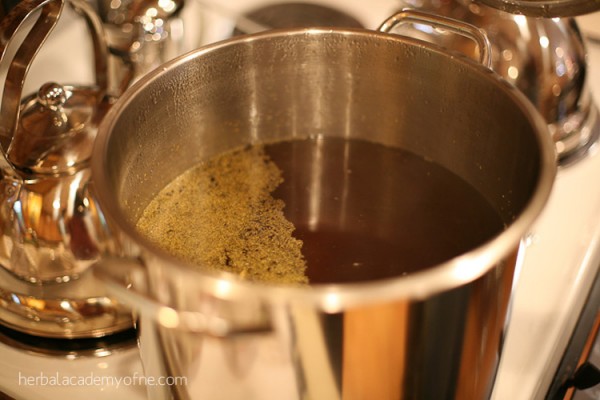
A Deeper Look at Herbal Infusions
Water is a very commonly used solvent that extracts herbal properties in the form of herbal infusions, or tea. Most people associate teas with hot water infusions, but cold infusions are also an easy way to create teas, especially in the summer months when cooling the body is necessary. Each of the methods has benefits depending on the herbal constituents desired.
For example, as Guido Masé has explained, polysaccharides extract well in cold infusion. Volatile oils will be altered slightly in hot infusions, but the extraction is done more quickly. Though cold infusions take longer, the delicate volatile oils will be more safely extracted. Tannins, lactones, and iridoids extract poorly in cold water.
Cold Infusions
It may be more beneficial to use cold infusions for herbs such as peppermint, chamomile, blessed thistle, and marshmallow. “This is usually due to the presence of mucilage or bitter principles that are denatured, to a certain extent, by boiling water” (Cech, 2000).
Cold water herbal infusions will break down the following plant constituents: sugars, proteins, albuminous bodies, gums, mucilaginous substances, pectins, plant acids, coloring matter, many mineral salts, glycosides, some alkaloids, most alkaloidal salts, and a hint of essential oils.
There are some barks like witch hazel, cascara sagrada, sumac, slippery elm, and buckthorn that will release their constituents in cold infusions very well. Roots of sarsaparilla and comfrey are also good candidates of cold infusion. Knowing the herb and the constituents will produce the best results.
Directions for Making Cold Infusions
To make a cold infusion, a standard ratio of 1:32 is used. (One ounce of herb and 32 ounces of water) If dried herbs are used, dampen the herbs before infusing. Place the herbs loosely into a tied muslin or cheese cloth bag. Secure the string in the jar lid so the herbs will float in the top part of the water.
This method is necessary, per Richo Cech, to allow clear water to flow through the tea bag, while the suffused water with herbal extractives is circulating downward. This “circulatory displacement” will then force the clear water back to the top of the jar where the herbs are floating.
After one or two nights, squeeze the bag of herbs into the tea. Some add water to the tea to bring liquid content up to 32 ounces. Others like it stronger so go by your taste.
This cold infusion method is used in “sun tea” by placing the jar with herbs and water outside in the summer sun or on a window with sun exposure for a few days. Moon tea is also a nice cold infusion to bring in feminine energy to the tea. Lemon balm, motherwort, blessed thistle, cramp bark make a great moon tea during a full moon. You can find all these herbs here.
Hot Water Infusions
Hot or boiling water will swell plant tissues and burst the cells of the herbs. By dissolving the starches and breaking down elements by disintegration, hot water temperatures can extract more of the precious vegetable tissues.
The first action to occur in the hot infusion is to break down sugars, gums, plant acids, mineral salts, and coloring matter. The next stage of this hot herbal infusion with new properties is to become a stronger solvent. Interestingly, as more dissolve from the herbs, the menstruum continues to be stronger in breaking down plant material. This is where more difficult elements such as tannins, lactones, and iridoids can now be extracted in water. Hot infusion evolves as it extracts.

The disadvantage of hot infusions is that it breaks down herbs very quickly and some of the foaming impurities will appear floating at the top of the liquid or be collected as scum at the bottom of the jar or pan. Harmless as both are, James Green recommends to strain off the “foam” and “scum” if syrup is being made from the infusion. Since tea only lasts for about two days, removing this discharge will also extend the tea life a couple more days.
Using dry herbs in a hot infusion has different affects than using fresh herbs. Dry herbs are brittle in the cell structure; therefore, lose some herbal qualities even with the hot water menstruum. A few herbs that extract well in fresh form are as follows: angelica, calendula, catnip, dandelion, gentian, horehound, lemon balm, lovage, plantain, self-heal, and thyme. You can get any of these herbs at Mountain Rose Herbs if you cannot find them locally. The flowers and leaves of these herbs create a vibrant color unmatched by dried herbs.
Conclusion
Different elements are broken down with each method of infusion using fresh or dry herbs. To help decide which herbs are best for cold infusion, I highly recommend Michael Moore’s list at: http://www.swsbm.com/ManualsMM/CldInfus.txt
Here are few cold infusion herbs from the web site. Note roots are listed.
Althea (Marshmallow,Hollyhock) ROOT and HERB
Angelica (Angelica) ROOT (GI tonic)
Anthemis nobilis (Roman Chamomile) FLOWERING HERB (Bitter Tonic)
Aralia nudicaulis (American Sarsaparilla) ROOT
Arctium (Burdock) ROOT
Artemisia absinthium (Wormwood) HERB
Artemisia tridentata (Sagebrush) HERB
Artemisia vulgaris (Mugwort HERB (gastric anti-secretory)
Hamamelis (Witch Hazel) BARK
Hyssopus (Hyssop) FLOWERING TOPS
Smilax (Sarsaparilla) ROOT/RHIZOME
Swertia (American Colombo) ROOT
Symphytum (Comfrey) ROOT
Find these herbs here.
This article is written by Sharyn Hocurscak, herbalist and President of Herbal Community of Central Massachusetts.
REFERENCES
Cech, Richo (2000) Making Plant Medicine. Williams, OR: The Horizon Herbs Publication
Green, James (2000) The Herbal Medicine-maker’s Handbook. Berkeley, CA :Crossing Press of Random House
Masé, Guido (2014) Interview by Sharyn Hocurscak. Montpelier, VT: www.vtherbcenter.org
Moore, Michael “Cold Infusion” list of herbs. Retrieved July 2014 from http://www.swsbm.com/ManualsMM/CldInfus.txt








